How to Create Product Attribute in Magento 2
With a big catalog of 234+ extensions for your online store
Product Attributes are items’ characteristics to set the products apart. Customers therefore can find the option they want based on looking at factors like color, size, material, or weight, etc. of the product. Once you create product attributes in Magento 2, you can upgrade customers’ experience and speed up their product search process. You can also use these attributes for further configuration relating to categories or CMS blocks.
Store owners can choose the way to create Attribute either during working on a product or from the Product Attributes page. In this topic I will introduce an easy way to create product attribute in Magento 2. Make sure you complete all three following steps to get the task done. You can add a new product attribute set here, or if you want to build a product recommendation system like Amazon, see how.
Following the easy guide given below to create product attribute in Magento 2
3 Steps to Create Product Attribute in Magento 2
- Step 1: Complete Basic and Advanced Properties information
- Step 2: Manage Labels Enter the Field Label
- Step 3: Describe the Storefront Properties
Step 1: Complete Basic and Advanced Properties information
- On the Admin panel, click
Stores. In theAttributessection, selectProduct - Click
Add New Attributebutton - In the
Attribute Propertiessection, do the following
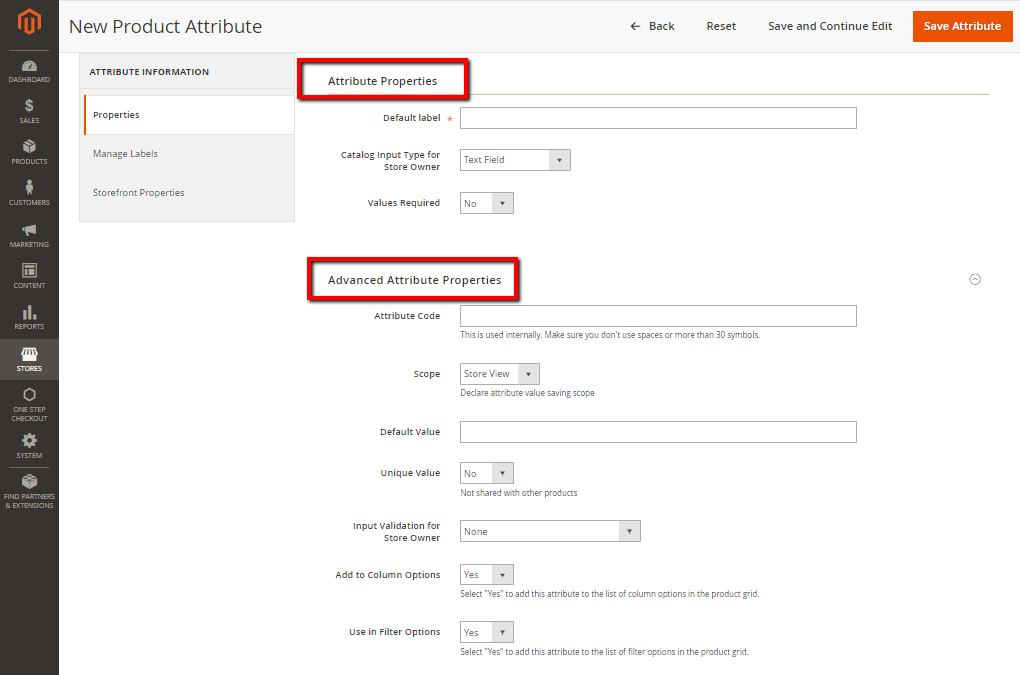
- In the
Default Label, enter a default label to identify the attribute - In the
Catalog Input Type for Store Ownerfield, select the type in input control to be used for data entry- Text Field
- Text Area
- Date
- Yes/No
- Multiple Select
- Dropdown
- Price
- Media Image
- Fix Product Tax
- Visual Swatch
- Text Swatch
Note: If you use Dropdown and Multiple Select input types, do the following
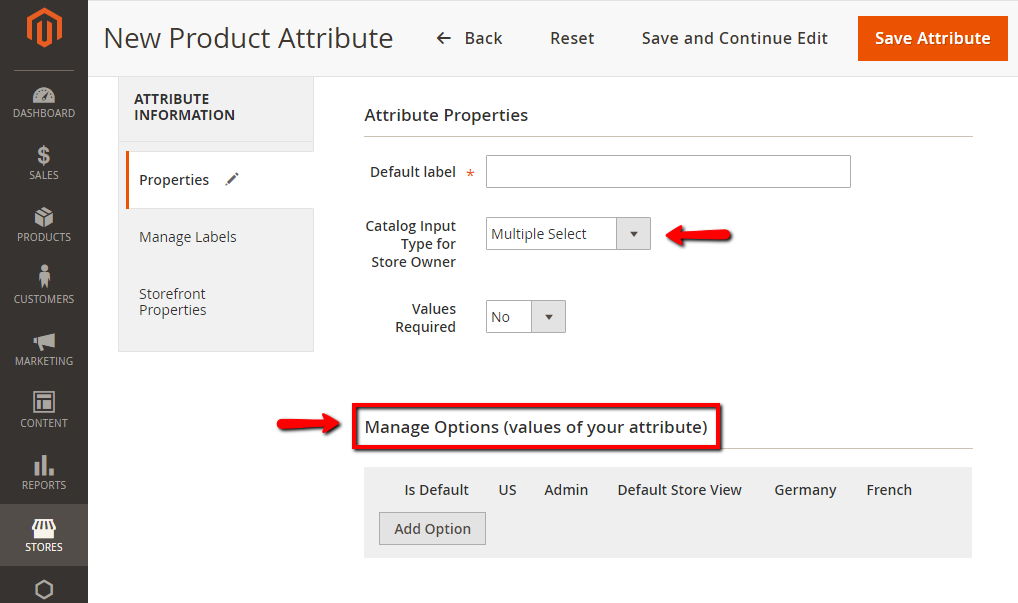
- Under
Manage Optionssection, clickAdd Optionbutton
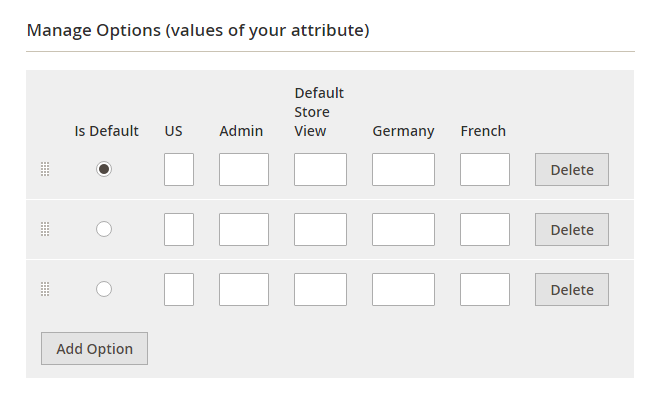
- Select Default if you use the option as the default value
- If you have only one store view, enter only the Admin value and it will be used for the storefront as well
- If you have multi store views, enter one value for the Admin and a translation of the value for each store view.
- Click on
Add Optionto create multi options that you want to include in the list - In the
Values Requiredfield, selectYesif you want to require the customers to choose an option before they can purchase products - In the
Advanced Attribute Propertiessection, complete the following (If needed)- In the
Attribut Codefield, enter a unique Attribute Code in lowercase characters, and without spaces. - In the
Scopefield, select one of the following to indicate where in your store hierarchy the attribute can be used- Website
- Store view
- Global
- In the
Unique Valuefield, set toYesif you want to prevent duplicate values from being entered - In the
Add to Column Optionsfield, set toYesto add this attribute to the list of column options in the product grid. - In the
Use in Filter Optionsfield, set to “Yes” to add this attribute to the list of filter options in the product grid.
- In the
Step 2: Manage Labels
- Open the
Manage Labelssection, do the following
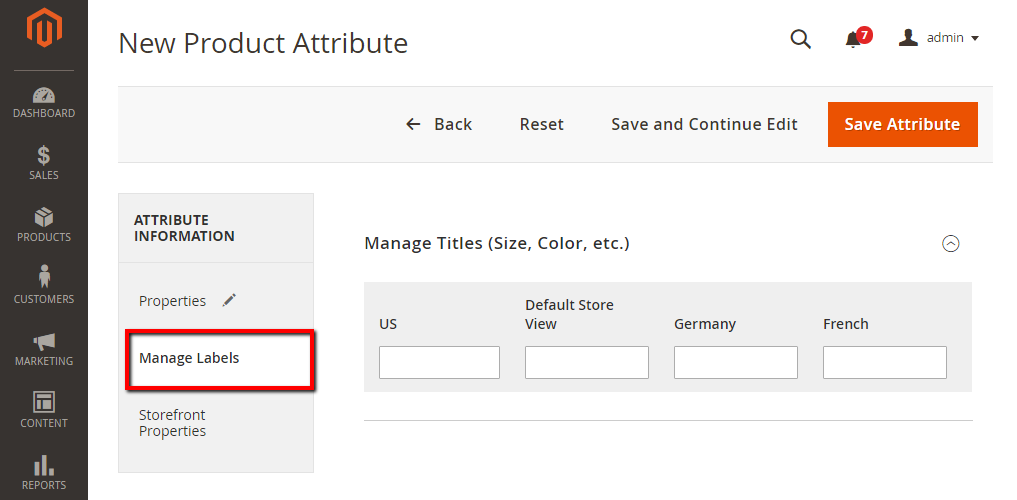
- Enter a title to be used as a label for the field. If your store is available in different languages, you can enter a translated title for each view.
Step 3: Describe the Storefront Properties
- Open the
Storefront Propertiessection, do the following
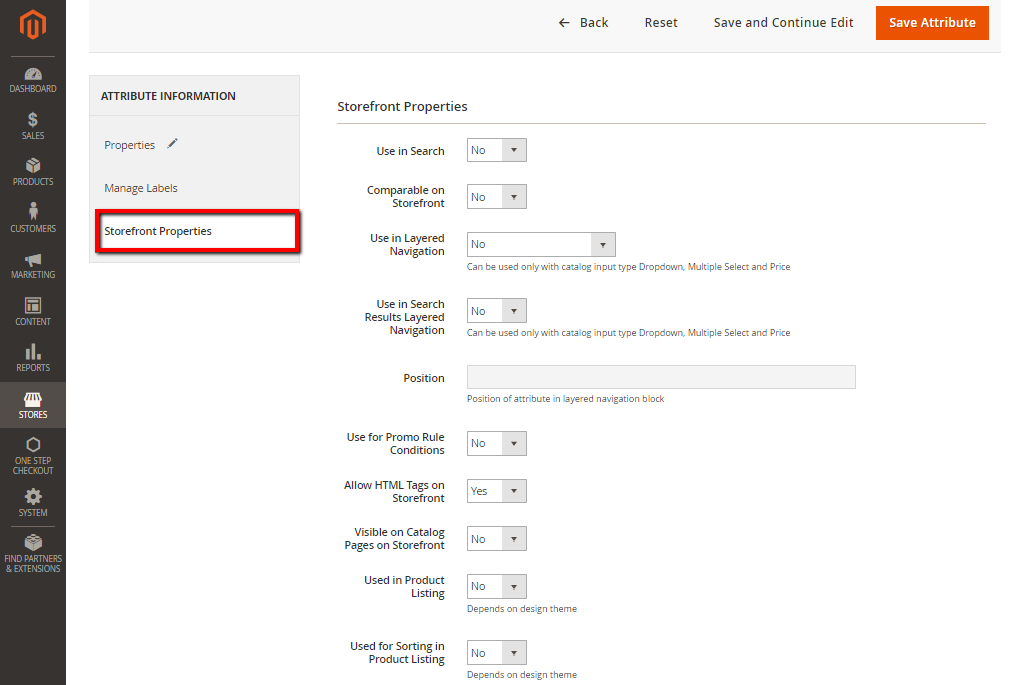
- In the
Use in Searchfield, set toYesif the attribute is to be available for search - In the
Comparable on Storefrontfield, set toYesto include the attribute in Product Compare - In the Use in Layered navigation field, set to
Yesif you want to use the attribute as a filter in layered navigation - In the
Use in Search Results Layered Navigationfield, set toYesif you want to use the attribute in layered navigation on search results pages - In the
Positionfield, enter a number to indicate the relative position of the attribute in the layered navigation block - In the
Use for Promo Rule Conditionsfield, set toYesto use the attribute in price rules - In the
Allow HTML Tags on Frontendfield, set toYesto allow the text to be formatted with HTML - In the
Visible on Catalog Pages on Storefrontfield, set toYesto include the attribute in catalog page listings - In the
Used in Product Listingfield, set toYesto include the attribute in product listings - In the
Used for Sorting in Product Listingfield, set toYesto use attribute as a sort parameter for product listings - When complete, click
Save Attributebutton.
The bottom line
Based on Product Attributes in Magento 2, customers can easily identify the suitable product, and therefore have a quicker decision-making process. In addition, stores can use it for configuration such as CMS Block or Category. This tutorial hopefully gives you enough details to conduct the task. If you need more help, please chat with us.
Related Topics
Looking for
Customization & Development Services?
8+ years of experiences in e-commerce & Magento has prepared us for any challenges, so that we can lead you to your success.
Get free consultantRecent Tutorials

Change Store Email Addresses

Fix Magento 2 'Invalid Form Key. Please refresh the page'

Magento 2 Search Settings: Default Magento vs Mageplaza AJAX Search
Explore Our Products:
People also searched for
- how to create attribute in magento 2
- magento 2 custom attributes
- magento 2 add attribute
- magento 2 manage attributes
- magento 2 product attributes
- how to create product attribute in magento 2
- how to add product attribute in magento 2
- magento 2 add attribute to product
- how to add attribute in magento 2
- magento 2 add product attribute
- magento 2 create product attribute
- create attribute in magento 2
- add new product attribute magento 2
- product attributes magento 2
- magento 2 product attribute
- product attributes in magento 2
- magento product attributes
- magento 2 edit attributes
- product attributes in magento
- magento product attribute
- add product attribute magento 2
- magento 2 create multi select product attribute programmatically
- create custom attribute in magento 2
- magento 2 custom product attribute
- magento 2 add attribute to product page
- 2.2.x, 2.3.x, 2.4.x
Stay in the know
Get special offers on the latest news from Mageplaza.
Earn $10 in reward now!




